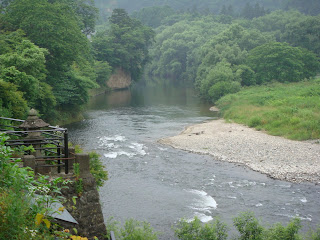Nothing much going on today - I just finished writing a test for my Business English class and have been grading a test I gave to my Science English classes. Since I have not been outdoors, I though that I would show you what a Japanese cell phone (
keitai meaning "mobile" or "pocket" in Japanese)looks like, especially the keyboard and its operation.

The first picture shows the phone when it is unfolded and ready to use.
The next picture shows a close up of the keyboard. You can see that it is not QWERTY format, rather it is like a calculator. Each key has three functions that can be access with two clicks: the upper left key and a number. This changes from numbers to Japanese to letters.

The numbers are simple, you press a key and you get a number. For example, if you press on the '2' key, you get the number '2' which can be used in telephone numbers, on the calculator function, etc.
The English letters are a bit more complicated. Let's again take the key with a '2' on it. You get into the English letter mode by pressing the top left key and then the '8' key, then first time you press on '2', you get the letter 'a', the next time a 'b' and so on. The complete sequence is "abcABC2". The other keys are similar. So you can see that typing in English is cumbersome and not very much fun.
Japanese, on the other hand, is surprisingly easy. As with letters, each key contains a sequence of
kana (meaningless phonetic symbols). For example, key '2' has the symbols for KA KI KU KE KO and key '1' has A I U E O. Again as with letters, these are accessed by sequential multiple presses.

However, the input process is much more efficient in Japanese. The last picture shows the screen when it is in the Japanese input mode. The screen is split into two sections. The top, just under the word "Message" contains what has been written and the current input. In this case the only thing there is the Japanese
kana 'a'. The bottom section of the screen is where the magic takes place. In side the white area, those hard to see characters contain all the words beginning with the
kana a. The list is dynamic so that the words that you personally use the most frequently are at the beginning of the list. If you input another
kana without pressing
enter, the list changes to contain only words beginning with that two
kana sequence. The words in the list can be brought to the top half by selecting them and pressing
enter. Although it is complicated to explain, the process is easy and efficient.
The
keitai has taken over Japanese culture and now wherever you go you will find people sending or receiving email through their
keitai. I have even seen a young woman with two
keitais - talking into one and texting on the other.
Keitais are becoming a problem in school. If you allow the student to use them during class, they can email friends for answers or go on the Internet and look for information. However, most
keitai now contain Japanese/English and Japanese/English dictionaries, so it is frequently difficult to ban them. There seems to be no good solution and as they acquire more advanced features, it will become even harder to keep them out of the classroom. I allow them anytime except during a test, when I do not allow dictionaries of any kind.
 Today is a rainy rainy season day. It is not raining hard but it is raining enough to make you wet after a little while. Ian and I met at Sendai Station at 6:30 and walk about 2 kilometers west to the Hirose River, much of which runs more or less through the middle of town. The part we walked on at first forms the western edge of the city. On side of the river is flat and build up, the other side is hills with only a few houses.
Today is a rainy rainy season day. It is not raining hard but it is raining enough to make you wet after a little while. Ian and I met at Sendai Station at 6:30 and walk about 2 kilometers west to the Hirose River, much of which runs more or less through the middle of town. The part we walked on at first forms the western edge of the city. On side of the river is flat and build up, the other side is hills with only a few houses.
















































